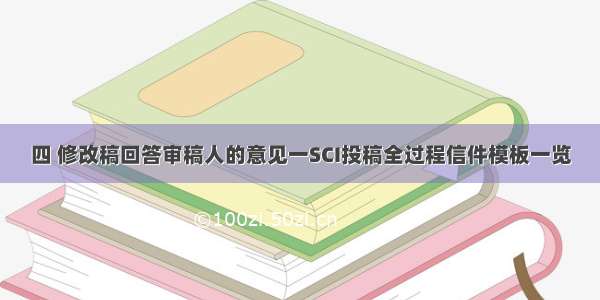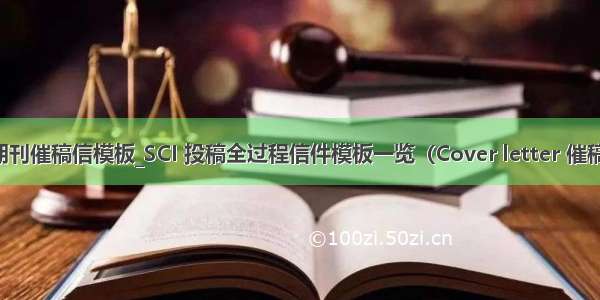
[zz] SCI 投稿全过程信件模板一览
SCI 投稿全过程信件模板一览(zz;比较过时,部分可参考)一、最初投稿
Cover letterDear Editors:We would like to submit the enclosed manuscript entitled “Paper Title”, which we wish to be considered for publication in “Journal Name”. No conflict of interest exits in the submission of this manuscript, and manuscript is approved by all authors for publication. I would like to declare on behalf of my co-authors that the work described was original research that has not been published previously, and not under consideration for publication elsewhere, in whole or in part. All the authors listed have approved the manuscript that is enclosed.In this work, we evaluated …… (简要介绍一下论文的创新性). I hope this paper is suitable for “Journal Name”.The following is a list of possible reviewers for your consideration:1) Name A E-mail: ××××@××××2) Name B E-mail: ××××@××××We deeply appreciate your consideration of our manuscript, and we look forward to receiving comments from the reviewers. If you have any queries, please don’t hesitate to contact me at the address below.Thank you and best regards.Yours sincerely,××××××Corresponding author: Name: ×××E-mail: ××××@××××
二、催稿信
Dear Prof. ×××:
Sorry for disturbing you. I am not sure if it is the right time to contact you to inquire about the status of my submitted manuscript titled “Paper Title”. (ID:文章稿号), although the status of “With Editor” has been lasting for more than two months, since submitted to journal three months ago. I am just wondering that my manuscript has been sent to reviewers or not?I would be greatly appreciated if you could spend some of your time check the status for us. I am very pleased to hear from you on the reviewer’s comments.Thank you very much for your consideration.
Best regards!
Yours sincerely,××××××
Corresponding author: Name: ×××E-mail: ××××@××××
三、修改稿
Cover letterDear Dr/ Prof..(写上负责你文章编辑的姓名,显得尊重,因为第一次的投稿不知道具体负责的编辑,只能用通用的Editors):On behalf of my co-authors, we thank you very much for giving us an opportunity to revise our manuscript, we appreciate editor and reviewers very much for their positive and constructive comments and suggestions on our manuscript entitled “Paper Title”. (ID:文章稿号).We have studied reviewer’s comments carefully and have made revision which marked in red in the paper. We have tried our best to revise our manuscript according to the comments. Attached please find the revised version, which we would like to submit for your kind consideration.We would like to express our great appreciation to you and reviewers for comments on our paper. Looking forward to hearing from you.Thank you and best regards.Yours sincerely,××××××Corresponding author:Name: ×××E-mail: ××××@××××四、修改稿回答审稿人的意见(最重要的部分)List of ResponsesDear Editors and Reviewers:Thank you for your letter and for the reviewers’ comments concerning our manuscript entitled “Paper Title” (ID:文章稿号). Those comments are all valuable and very helpful for revising and improving our paper, as well as the important guiding significance to our researches. We have studied comments carefully and have made correction which we hope meet with approval. Revised portion are marked in red in the paper. The main corrections in the paper and the responds to the reviewer’s comments are as flowing:Responds to the reviewer’s comments:Reviewer #1: 1. Response to comment: (……简要列出意见……)Response: ××××××2. Response to comment: (……简要列出意见……)Response: ××××××。。。。。。逐条意见回答,切忌一定不能有遗漏针对不同的问题有下列几个礼貌术语可适当用用:We are very sorry for our negligence of ……...We are very sorry for our incorrect writing ……...It is really true as Reviewer suggested that……We have made correction according to the Reviewer’s comments.We have re-written this part according to the Reviewer’s suggestionAs Reviewer suggested that……Considering the Reviewer’s suggestion, we have ……最后特意感谢一下这个审稿人的意见:Special thanks to you for your good comments. Reviewer #2:同上述Reviewer #3: ××××××Other changes: 1. Line 60-61, the statements of “……” were corrected as “…………”2. Line 107, “……” was added 3. Line 129, “……” was deleted ×××××× We tried our best to improve the manuscript and made some changes in the manuscript.These changes will not influence the content and framework of the paper. And here we did not list the changes but marked in red in revised paper.We appreciate for Editors/Reviewers’ warm work earnestly, and hope that the correction will meet with approval.Once again, thank you very much for your comments and suggestions.
五、文章接受后可以考虑感谢一下负责你文章的编辑或主编(根据需要)
Dear Prof. ××××××:Thanks very much for your kind work and consideration on publication of our paper. On behalf of my co-authors, we would like to express our great appreciation to editor and reviewers.Thank you and best regards.Yours sincerely,××××××Corresponding author:Name: ×××E-mail: ××××@××××六、询问校稿信件(如果文章接受后时间较长)Dear ×××:Sorry for disturbing you. I am not sure if it is the right time to contact you to inquire about the status of our accepted manuscript titled “Paper Title” (ID:文章稿号), since the copyright agreement for publication has been sent to you two months ago. I am just wondering that how long I can receive the proof of our manuscript from you?I would be greatly appreciated if you could spend some of your time for a reply. I am very pleased to hear from you.Thank you very much for your consideration.Yours sincerely,××××××Corresponding author:Name: ×××E-mail: ××××@××××
七、文章校稿信件
Dear Mr. ×××:Thanks very much for your kind letter about the proof of our paper titled “Paper Title” (ID:文章稿号) for publication in “Journal Name”. We have finished the proof reading and checking carefully, and some corrections about the proof and the answers to the queries are provided below. Corrections:1. In ****** should be **** (Page ***, Right column, line***)2. In **** the “*****” should be “****” (Page ****, Right column, line****)Answers for “author queries”:1. *********************.2. **********************3. **********************We greatly appreciate the efficient, professional and rapid processing of our paper by your team. If there is anything else we should do, please do not hesitate to let us know.Thank you and best regards.Yours sincerely,××××××Corresponding author:Name: ×××E-mail: ××××@××××
SCI投稿的一些套话
一投稿信
1. Dear Dr. Defendi ML:
I am sending a manuscript entitled “” by – which I should like to submit for possible publication in the journal of - .
Yours sincerely
2. Dear Dr. A:
Enclosed is a manuscript entitled “” by sb, which we are submitting for publication in the journal of - . We have chosen this journal because it deals with - . We believe that sth would be of interest to the journal’s readers.
3. Dear Dr. A:
Please find enclosed for your review an original research article, “” by sb. All authors have read and approve this version of the article, and due care has been taken to ensure the integrity of the work. No part of this paper has published or submitted elsewhere. No conflict of interest exits in the submission of this manuscript, and we have attached to this letter the signed letter granting us permission to use Figure 1 from another source.
We appreciate your consideration of our manuscript, and we look forward to receiving comments from the reviewers.
二、询问有无收到稿件
Dear Editors,
We dispatched our manuscript to your journal on 3 August but have not, as yet, receive acknowledgement of their safe arrival. We fear that may have been lost and should be grateful if you would let us know whether or not you have received them. If not, we will send our manuscript again. Thank you in advance for your help.
三、询问论文审查回音
Dear Editors,
It is more than 12 weeks since I submitted our manuscript (No: ) for possible publication in your journal. I have not yet received a reply and am wondering whether you have reached a decision. I should appreciated your letting me know what you have decided as soon as possible.
四、关于论文的总体审查意见
1. This is a carefully done study and the findings are of considerable interest. A few minor revision are list below.
2. This is a well-written paper containing interesting results which merit publication. For the benefit of the reader, however, a number of points need clarifying and certain statements require further justification. There are given below.
3. Although these observation are interesting, they are rather limited and do not advance our knowledge of the subject sufficiently to warrant publication in PNAS. We suggest that the authors try submitting their findings to specialist journal such as –
4. Although this paper is good, it would be ever better if some extra data were added.
5. This manuscript is not suitable for publication in the journal of – because the main observation it describe was reported 3 years ago in a reputable journal of - .
6. Please ask someone familiar with English language to help you rewrite this paper. As you will see, I have made some correction at the beginning of the paper where some syntax is not satisfactory.
7. We feel that this potentially interesting study has been marred by an inability to communicate the finding correctly in English and should like to suggest that the authors seek the advice of someone with a good knowledge of English, preferable native speaker.
8. The wording and style of some section, particularly those concerning HPLC, need careful editing. Attention should be paid to the wording of those parts of the Discussion of and Summary which have been underlined.
9. Preliminary experiments only have been done and with exception of that summarized in Table 2, none has been repeated. This is clearly unsatisfactory, particularly when there is so much variation between assays.
10. The condition of incubation are poorly defined. What is the temperature? Were antibody used?
五、给编辑的回信
1. In reply to the referee’s main criticism of paper, it is possible to say that –
One minor point raised by the referee concerns of the extra composition of the reaction mixture in Figure 1. This has now been corrected. Further minor changes had been made on page 3, paragraph 1 (line 3-8) and 2 (line 6-11). These do not affect our interpretation of the result.
2. I have read the referee’s comments very carefully and conclude that the paper has been rejected on the sole grounds that it lake toxicity data. I admit that I did not include a toxicity table in my article although perhaps I should have done. This was for the sake of brevity rather than an error or omission.
3. Thank you for your letter of – and for the referee’s comments concerning our manuscript entitled “”. We have studied their comments carefully and have made correction which we hope meet with their approval.
4. I enclosed a revised manuscript which includes a report of additional experiments done at the referee’s suggestion. You will see that our original findings are confirmed.
5. We are sending the revised manuscript according to the comments of the reviewers. Revised portion are underlined in red.
6. We found the referee’s comments most helpful and have revised the manuscript
7. We are pleased to note the favorable comments of reviewers in their opening sentence.
8. Thank you for your letter. I am very pleased to learn that our manuscript is acceptable for publication in Cancer Research with minor revision.
9. We have therefore completed a further series of experiments, the result of which are summarized in Table 5. From this we conclude that intrinsic factor is not account.
10. We deleted the relevant passage since they are not essential to the contents of the paper.
11. I feel that the reviewer’s comments concerning Figures 1 and 2 result from a misinterpretation of the data.
12. We would have include a non-protein inhibitor in our system, as a control, if one had been available.
13. We prefer to retain the use of Table 4 for reasons that it should be clear from the new paragraph inserted at the end of the Results section.
14. Although reviewer does not consider it is important to measure the temperature of the cells, we consider it essential.
15. The running title has been changed to “”.
16. The Materials and Methods section now includes details for measuring uptake of isotope and assaying hexokinase.
17. The concentration of HAT media (page12 paragraph 2) was incorrectly stated in the original manuscript. This has been rectified. The authors are grateful to the referees for pointing out their error.
18. As suggested by both referees, a discussion of the possibility of laser action on chromosome has been included (page16, paragraph 2).
19. We included a new set of photographs with better definition than those originally submitted and to which a scale has been added.
20. Following the suggestion of the referees, we have redraw Figure 3 and 4.
21. Two further papers, published since our original submission, have been added to the text and Reference section. These are:
22. We should like to thank the referees for their helpful comments and hope that we have now produced a more balance and better account of our work. We trust that the revised manuscript is acceptable for publication.
23. I greatly appreciate both your help and that of the referees concerning improvement to this paper. I hope that the revised manuscript is now suitable for publication.
24. I should like to express my appreciation to you and the referees for suggesting how to improve our paper.
25. I apologize for the delay in revising the manuscript. This was due to our doing an additional experiment, as suggested by referees.
本文来自:小木虫论坛/bbs/viewthread.php?tid=2287267
反驳审稿人意见的范文
Dear Editor,
As the corresponding author, I received an e-mail which informed me that our manuscript (Ref: ……) has been rejected. A referee’s report, as a standard procedure, has been attached to it.
I have not the slightest grudge against the rejection. However, the referee’s report is quite unconvincing, or, if I may say, somewhat irresponsible. I understand that ||| is an honorable organization which has a distinct reputation of being most conscientious toward all the submissions around the world. Those careless remarks in the report might jeopardize the good image which ||| has been well upholding. So I consider it a self-imposed obligation to point it out.
Just for the sake of argument, please allow me to cite the first and the only referee’s report below.
We dispatched our manuscript to your journal on 3 August but have not, as yet, receive acknowledgement of their safe arrival. We fear that may have been lost and should be grateful if you would let us know whether or not you have received them. If not, we will send our manuscript again. Thank you in advance for your help.
SCI论文全攻略之构思与撰文
(1)注意句子上下连贯,不能让句子独立。
常见的连接词有,However, also, in addition, consequently, afterwards, moreover, Furthermore, further, although, unlike, in contrast, Similarly, Unfortunately, alternatively, parallel results, In order to, despite, For example, Compared with, other results, thus, therefore……用好连接词能使文章层次清楚,意思明确。比如,叙述有时间顺序的事件或文献,最早的文献可用AA advocated it for the first time.接下来可用Then BB further demonstrated that.再接下来,可用Afterwards, CC……如果还有,可用More recent studies by DD……如果叙述两种观点,要把它们截然分开AA put forward that……In contrast, BB believe or Unlike AA, BB suggest or On the contrary (表明前面观点错误),如果只表明两种观点对立,用in contrast BB……如果两种观点相近,可用AA suggest……Similarily, alternatively, BB……Or Also, BB or BB allso does……表示因果或者前后关系可用Consequently, therefore, as a result……表明递进关系可用furthermore, further, moreover, in addition……写完一段英文,最好首先检查是否较好地应用了这些连接词。
第一段要明确告诉读者你要讨论几个部份……Therefore, there are three aspects of this problem have to be addressed. The first question involves……The second problem relates to……The third aspect deals with……清晰地把观点逐层叙述。也可以直接用First, Second, Third, Finally……当然,Furthermore, in addition等可以用来补充说明。
(3)讨论部份的整体结构:小标题是把问题分为几个片段的好方法。通常第一个片段指出文章最重要的数据或结果;补充说明部份放在最后一个片段。一定要明白,文章的读者分为多个档次;除了本专业的专业人士读懂以外,一定要想办法能让更多的外专业人读懂。所以可以把讨论部份分为两部份,一部份提出观点,另一部份详细介绍过程以及论述的依据。这样专业外的人士可以了解文章的主要观点,比较专业的讨论他可以把它当成黑箱子,而这一部份本专业人士可以进一步研究。为使文章清楚,第一次提出概念时,最好以括弧给出较详细解释。如文章用了很多Abbreviation可用两种方法解决:(1)在文章最后加上个Appendix,把所有Abbreviation列表;(2)在不同页面上不时地给出Abbreviation的含义,用来提醒读者。
三、撰写外刊论文的体会
有人归纳了外刊论文撰写的五个基本要求,即5C:正确(correctness)、清楚(clarity)、简洁(concision)、完整(completion)和一致性(consistency)。只有满足这5点,才算是一篇合格的外刊文章。
1. Introduction:ntroduction是外刊文章最难写的部分之一(另外就是Discussion)。中文文章的缺陷就在于Introduction没有内涵,过于简单,没有真正体现论文的研究起初和创新要素。外刊论文对于Introduction的要求是非常高的,一个好的Introduction相当于文章成功了一半。所以大家应该在Introduction的撰写上下功夫。要写好Introduction,最重要的是要保持鲜明的层次感和极强的逻辑性,这两点是紧密结的,即在符合逻辑性的基础上建立层层递进的关系。
A.阐述自己研究领域的基本内容。要尽量简洁明了,不罗嗦;须知看文章者都是该领域的专家,所以一些显而易见的知识要用概括性的而不是叙述性的语言来描述。
B.文献总结回顾。是Introduction的重头戏之一,要特别着重笔墨来描写。一方面要把该领域内过去和现在的状况全面概括总结出来,不能有丝毫的遗漏,特别是最新的进展和过去经典文献的引用(这是两个最容易出问题的地方,要极力避免;一旦审稿人指出这两个毛病,很可能意味着表明你做的不够深入或全面,负面作用非常明显)。另一方面,文献引用和数据提供一定要准确,切记避免片面摘录部分结果而不反映文献的总体结果;引用的数据也要正确,特别是间接引用的数据(即不是从原文献中查到,而是从别人文献中发现的另一篇文献的数据);数据出错会导致文章的印象特差!此外,引用文献时注意防止造成抄袭的印象,即不要原文抄录,要用自己的话进行总结描述。如果审稿人正好是文献的引用者的话,原文照抄的结果一定会很糟糕。
C.分析过去研究的局限性并阐明自己研究的创新点。这是整个Introduction的高潮,因而要慎之又慎。阐述局限性时,需要客观公正评价别人的工作,不要把抬高自己研究的价值建立在贬低别人的工作之上(这是中文文章易犯的毛病),外刊论文写作万万不可如此,一定要遵循实事求是的原则来分析。在阐述自己的创新点时,要紧紧围绕过去研究的缺陷性来描述,完整而清晰地描述自己的解决思路。需要注意文章的摊子不要铺的太大,要抓住一点进行深入的阐述。只要能够很好的解决一个问题,就是篇好文章;创新性描述的越多越大,越容易被审稿人抓住把柄。中文文章的特点是创新性要多要大,而英文文章的特点恰恰相反,深入系统的解决一到两个问题就算相当不错。
D.总结性描述论文的研究内容,可以分为一二三四等几个方面来描述,为Introduction做最后的收尾工作。至此,Introduction的写作算是大功告成。但是写完之后,还是要慎之又慎的仔细修改,琢磨每一个句子是否表达得恰当准确,这对Introduction的修改完善至关重要。
2. Methods:
Methods部分描述论文实验过程,这一过程的写作相对较为简单,但是需注意的问题不少,重要的在于完整和科学。完整就是实验当中的每一个环节都要注意到,不要顾此失彼,遗漏一些重要内容。Methods部分可按实验对象、实验设备、实验材料、实验记录、实验分析方法等来组织行文。只要能在以下4个方面做到完整和科学的描述,相信写好Methods不是主要问题。
A.实验对象一般是人、动物或一些组织等,它们的基本信息要描述明确;此外要注意国外刊物大多对牵扯到人或动物的实验都有一些特定要求,有些是不允许在人或动物身上进行的实验操作,这需要认真阅读投稿刊物中关于实验的详细规定;如果违反这一规定,可能会不接受评审或发表。
B.实验设备,要对仪器型号、生产厂家、实验过程中的用途等作详细说明;实验设备之间的连接要科学正确,不要给人混乱或操作错误的感觉。设备使用时一些必要的步骤不可或缺,尤其是可能对实验结果造成特定影响的操作更要详细说明。这样做的好处是为了在Discussion中能够进行对应的分析。比如,一些设备在使用前要校正(calibration),有的要求每阶段实验之后都要重新校正,以保证结果的正确性;一定要详细说明你的操作步骤或校正过程,便于评审人分析你的结果。
C.实验材料,不同学科有不同要求。总体上来说要注意说明材料选择的必要性,也就是对为什么要选择这种材料,最好有一定的说明。如果这点描述不清,可能会导致整个实验过程不成立。
D.实验过程,就是清楚描述实验的整个操作流程,一般要附以实验流程图进行说明。流程图的画法很多,有文字式的,有文字和示意图结合的,不同实验有不同做法。一般来说,可能后者多一些(实验性学科尤其如此),因为这样能使评审人对实验过程一目了然。如果示意图画得漂亮,还可以增加一些印象分。描述时要有鲜明的层次感,对每个步骤之间的顺序和关联要描述清楚,不要造成实验过程混乱不堪的印象,因为评审人最终判断你的实验是否合理,是从这个过程描述得来的。
3. Results:
有人把Results和Discussion放在一起写,但是大多数论文都是分开的。这两种做法取决于文章的类型。如果你的结果在分析的同时进行讨论更加合适,并不适合单独拿出来分析(或者是那样做很困难,导致Discussion成为鸡肋时),合在一起是合适的;反之就应该分开写。
A. Results的要求是翔实准确。准确是结果必须是真实的,不能伪造和篡改。翔实是提供最全面的分析结果,把一切从实验中得到的结果都提供给读者,不要故意隐瞒或遗漏某些重要结果。从某种意义上来说,结果不够翔实并不导致论文直接被拒,但结果的真实性被怀疑文章就肯定被拒。
.结果提供一般是表和图。不同杂志对图表要求不完全一致,应根据杂志要求分别对待。表格能清晰展示论文获得的第一手结果,便于后人在研究时进行引用和对比。图示能将数据的变化趋势灵活的表现出来,更直接和富于感染力。图表结合,能取长补短,使结果展现更丰富。目前,大家越来越喜欢提供各种各样的图,但杂志却要尽量限制图的个数;因为会增加排版的困难,版面费和出版社的支出也就会增加。因此,建议大家在提供图时,尽量用最少的图提供最多的信息,最多不超过8个。图片太多显得罗索和累赘,主编不会欣赏;必要时可用表格替代一些图。图片格式要求每个杂志不同,用tif格式较多,不推荐用bmp(jpg更不能用)。有人说用矢量图清楚些,其实和tif没什么区别,只要足够清晰就行。黑白图片可免费,彩色图片绝对要收费,而且价格不菲。
4. Discussion:
Introduction和Discussion是最难写的两部分。Discussion之所以难写,是因为这里面最能够显示一个作者研究问题的深度和广度。深度就是论文对于提出问题的研究到了一个什么样的程度,广度指是否能够从多个角度来分析解释实验结果。要写好Discussion,大概可以分为下面两个步骤:
A.选择要深入讨论的问题。Results中有的结果是重要的,有的则可一笔带过。选择合适的结果在Discussion部分进行深入讨论,是写好该部分首先要面临的问题。一般来说,可根据如下原则来判断:如果你的结果体现了实验的独特性,是其他研究中没有得到的,那这个结果就是要重点讨论的问题;有些结果和前人的研究一致,并没有显著性差异,就应该一笔带过而无需深入讨论。Discussion的一个重要作用就是要突出自己研究的创新性,并体现出显著区别于他人的特点,区别大和小是另外一个问题,重要的是要有区别、区别就是创新。
B.对选中的问题按一定层次从多个角度进行讨论,说理要有根据、问题要讲清楚、讲透彻。选择的问题有时不只一个(多数情况是2个以上),因此要按一定层次描述清楚。一般来说,把最重要的放在中间,次之的放开头和末尾。放在中间能将评审人的情绪带至高潮,前面是铺垫,后面是总结。这样的顺序似乎更合适。问题无论大小,是否重要,都要从多个角度展开深入讨论:(1)首先要有类似结果的对比,说明自己结论的独特性;(2)其次要系统阐述为什么会有这样的结果,方法有多种(从实验设计角度,从理论原理角度,从分析方法角度,或借鉴别人分析方法等等)。重要的是将这个问题深入阐述清楚,不能让人有意犹未尽之感(要做到这点的确很困难,因为评审人总会提出新的问题,我们只可能尽量做到这一点罢了)。
C. Discussion部分还要注意保持和Results的一致性!就是结果和讨论要一一对应。千万不要出现按讨论的内容可以推出与实验相反的结论这种情形,那证明你的讨论思路是彻底的失败或你的实验压根儿就是失败的。所以Discussion的文字描述和语言表达的精确性尤为重要。由于中英文表达的不同,在投稿之前要尽量避免出现表达上的误解,如果论文因此被拒是很冤枉的。
5. Acknowledge & References:
Acknowledge主要分为两个:第一是表明研究的基金来源,中国一般都是Nature Science Foundation of China(NSFC,国家自然科学基金),美国大多是National Institute of Health(NIH,美国国家卫生研究院)。写基金时一般要标注清楚基金号码(Grant Number),只有这样才算是该项基金的研究成果,也可以算做实验室的研究成果。须知没有任何一项研究成果是在没有资金资助的情况下完成的,所以这一点非常必要。第二是对参与人员(没有列在作者中的研究人员)和单位表示感谢,如果通过一审和最终接受发表,还要添上对editor和anonymous reviewers的感谢,这是基本礼貌。
References重要在于格式。不同杂志对参考文献格式要求不一样,具体下来有所区别的可以分为:作者的写法,有的是简写在前,有的简写在后,有的简写有点,有的简写没有点;文章的名字,有的要加上引号,有的没有引号;期刊的写法,有的要简写,有的要全称,有的要斜体,有的则不需要;年和期卷号的顺序,有的是年在前,有的是年在后;期刊论文、书、学位论文、会议论文,四种引用的格式各不相同;文献的排列顺序,有的是按照字母的顺序,有的则是按照在论文中出现的顺序用阿拉伯数字排序。基本上就是这些问题,看来很是琐碎,但是如果你的参考文献排列的乱七八糟,那就会使得评审人对你论文的印象很差,认为你没有认知组织和撰写论文,造成一定的负面影响。所以,事情虽小,影响却大,还是要认真组织为好。
此外,论文在撰写时要自始至终都用英语写,千万不要先写中文再译成英文。这样写出来的文章肯定是中不中,英不英,而且极大浪费精力。宁可一开始写得语法差一些,慢慢修改都比这种写法好。如果有同专业英语比较好的人帮助的话,这样写还会更省事。写作时行文时态要注意,中文没有时态问题,英文有,而且要求还相当严格。一般来说,大多数情况下是过去时态,在Introduction文献回顾,Methods整个部分,Results结果总结,Discussion中的大部分,都用过去时态陈述。其他情况下可以用一般时态来描述。时态之间的界限是比较严格的,最好是仔细的通读国外的论文,好好分析一下,或者让有经验的人帮你把把关,这样比较好一些。
四、Writing Skills in English for Research Paper
写paper注意九个环节:Preparation, Structure, Title, Abstracts, Introduction, Conclusion, Body of Paper, Recision, Acknowledgement。Preparation就是收集资料,找出灵感和方向,主要依靠的是journal in library。Structure是重点,paper的structure应该是两个triangle组成的:上面一个倒三角,下面一个正三角,意思就是选题要宽(wide),研究方向要窄,然后最后的conclusion又发散开来。在paper的body前后都必须有declarative statement,用最少的字句表达出自己的观点,吸引读者。
Title必须清晰简短(clear,short),表达出自己唯一的topic以提升读者的兴趣(promote the interest of reader),然而title中切记不能出现abbreviation和自己的result。
Abstracts是paper的一个缩写(miniature of whole paper),一定要简明扼要(less than 200 words,one paragraph),按照paper的顺序介绍主要研究对象(subject)、实验设计(design)、实验步骤(procedures)以及最后结果(results),这种介绍必须让非专业的人员(non-specialist)能够看懂。
Introduction同样要保证简短,顺序是一般背景介绍、别人工作成果、自己的研究目的及工作简介,其中介绍别人工作时只需介绍和自己最相关的方面(very relevant),而对自己的工作介绍不用说明细节,因为这个要放到body中去。不要忘记在介绍自己工作之前要有一个declarative statement。
Body部分可以分为methods、result和discussion三个部分:①Methods,详尽的介绍自己的实验方案以便于他人能够重复自己的实验过程,对于通用的实验方案可以简略,重点要放到自己的独创方案上面(own procedures),按照实验的先后顺序介绍,为了文章的阅读方便,不要使用过多层次的subheadings,比如subsubsubsection等等。②Result,使用text、table、figure等手段表达出来,其中table不要使用过多,而figure必须保证图线清楚、注解明确,必要的时候还要对于自己的result中的一些结论进行解释说明。③Discussion,这个部分是为了以后的study,在其中提出自己的problem或者是hypothesis,和别人的成果进行比较,暗示自己的主要收获,为后面的conclusion做准备。
Conclusion中不要包含body以外的information,保持brief、neat和concise,一定要舍得结束自己的paper;如果自己的paper只是project的一部分,稍做说明。Revison是在写完之后回头看看是否有逻辑上的错误,是否考虑到了读者兴趣,自己的declarative statement是否令人满意,Brevity is the soul of literary construction。Acknowledgement,不要忘记,这个反应了一个人的个人品质。
五、撰写论文初稿(writing the first draft):
(1)材料和方法(methods and materials):做了什么和怎样做?材料和方法是文章开始写作的最理想部分,这部分的内容作者最了解。写作要求:用过去时,尽可能按实验的先后顺序描述。
(2)结果(results):发生了什么?基本写作要求:可用图、表或文字表达,三者间尽量减少重复。在正文部分叙述主要结果和意义,用图或表给出较详细的数据,用过去时。
(3)讨论(discussion):所得结果是否为“前言”提出的关键问题的答案?结果是如何支持答案的、如何证实假说的?基本写作要求:集中讨论与本结果有关的问题,突出本研究的创新及重要性,;与相关研究结果进行比较分析;给出结果所支持的结论;指出前景、不足和改进。用现在时叙述已知或被证明的事实,用过去时描述本研究结果。
(4)文献(references):与本研究方法、结果、讨论有关的其它研究有哪些?准确完整规范著录。
(5)前言(introduction)本研究的背景和目的是什么?试图回答的关键问题是什么?基本写作要求:本研究之目的和重要性;简要复习文献。
(6)致谢(acknowledgment):除了作者,谁协助完成了本研究、分析结果并撰写论文?谁提供了基金和物质帮助?写作要求:仅列出对本工作提供特殊的实质性贡献者姓名;须得到被致谢者同意。
(7)摘要(abstract):论文告诉我们什么(通常<250字)?摘要是论文要点的浓缩,应在文章各主要部分完成后再写,这样有利于文章要点的提炼。优秀的摘要能有效抓住读者兴趣。写作要求:用含有必要词汇的短的简单句,以使摘要清楚而简洁?避免使用缩写词和晦涩难懂的词句;用小标题叙述研究论文的各部分;用过去时(但问题的陈述和结论可用现在时);强调研究的创新和重要方面。
(9)作者(author list):谁参与了本研究的设计、工作及论文的撰写?
(10)准备论文最后一稿(preparing the final manuscript):论文初稿完成以后,必须对内容及格式进行反复推敲和修改,达到“投稿须知”的一切要求。绝大多数有经验的编辑都认为:不认真准备的稿件绝不是高水平科学研究成果的良好载体(A poorly prepared manuscript is,almost without fail,the carrier vehicle of poor science. Day AR.)。如果希望论文发表,在准备投稿时必须做到打字整洁、无错、符合期刊格式、含有期刊要求的所有材料。该过程一般分三步:再次阅读拟投期刊的“投稿须知”;用“投稿须知”中提供的“稿件对照检查表”(manuscript checklist, author's checklist)与自己论文一一核对;根据期刊要求打印输出,完成最后一稿。
索取文献范文
Dear XXXXX,
Thank you for your prompt answer and sending me the paper.In fact I am updating my reference search and 4 of your papers are inlcuded in my review.
Best whishes,
XXXXXX
下面是他上月写给我的邮件:
Dear XXXXXX,
I am working on a review paper entitled "Efficient, selective, and recyclable heterogeneous palladium catalysts in C-C coupling reactions" which is going to be published in Current Organic Synthesis early next year. According to the abstract found in Web of Science your paper below will nicely fit into the topic of the review. Since I do not have access to the original journal may I kindly ask you to send me the electronic copy if available of your following paper:XXXXXXXX.
Thank you, in advance, for your cooperation,
Best whishes,
Prof. XXXXXX
Department of Organic Chemistry
University of XXXXX
XXXXXX
















